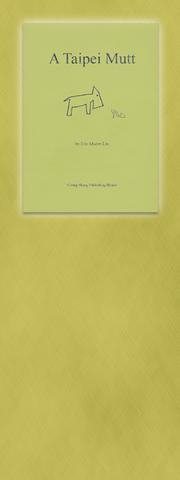I picked this book up in a Taipei bookstore. Surely it would be of interest, I thought, and anyway it was only NT$250. As I began to read I saw that the writer had considerable control of style of the tone of voice of his narrator. Here, anyway, was someone who knew what he was doing.
Perhaps, I thought, it was autobiographical, like so many novels. A young American, aged 29, arrives in Taipei to take up a job teaching English. He stumbles through the heat and humidity, but can't find where he's looking for because everything's written in Chinese. Even the Taipei phone book's in Chinese. (How do they arrange the alphabetical order, he wonders). In the end he settles for a cup of tea that appears to contain frogspawn.

The sense of reality doesn't let up when he encounters a fashionably-dressed young woman at a bank, still on his first day in the city, allows himself to get picked up, and accompanies her back to her apartment for a wild sex session. The only strange thing is the number of dogs she has in her yard.
Then suddenly all chances of the book being a simple slice of autobiography disappears as the woman turns out to be a magician, and at the height of their passion changes the man into a dog, and sends him outside to join the others.
What happens next is that the young man, now a dog, starts experiencing the city. He gets hit by a car and spends the night in the entrance to an MRT station. He hangs around in the hope of getting food outside restaurants and noodle stalls. So this was going to be a satire, I thought, the world of Taipei seen from the perspective of a mutt. Well, there were plenty of precedents. From Gulliver's Travels to Alice in Wonderland we've had the absurdities of societies exposed by a simple change of scale. And Franz Kafka's Metamorphosis has the hero waking up to find he's changed into a cockroach. Fair enough. Any story needs a device to hang it on, and this one was certainly as good as any other.
But as I read on I began to wonder. Among the details of Taipei life there were extended fantasies and learned dialogues. What was this, I asked myself. Who was this author? What was he up to? What kind of game was he playing?
The writer was clearly no literary novice tapping away at his computer. He used words like glossolalia, pablum and commensurate. Perhaps it was more autobiographical than I'd supposed after all. The narrator had stated early on that he'd studied Greek and Latin, was passably fluent in French and German, and had written a dissertation on the second-century Greek satirist Lucian. He'd just missed becoming an academic, and thought a spell of language teaching might be more interesting than taxi-driving. Was this, then, in fact a portrait of Eric Mader-Lin himself?
The plot soon settled down to something not uncommon in the annals of fiction, the search for the perfect woman. The dog believes the only time he is going to be changed back into a man is at the same moment of sexual ecstasy in which the change occurred in the other direction. A woman is needed, therefore, who'll so love her mutt that she'll allow him to sleep alongside her, on her bed, and maybe even in it. The rest, with luck, will follow naturally.
He soon identifies the object of his desire, all of 15 probably, and her scent like electric nectar. As she stoops down to stroke him, he responds by licking her ankle. "Let's break all the laws we can," he pants, "because laws, you know, laws were made as grist for the mill of our entwined legs. We'll grind the laws to pulp between the thrashing of our parts. We were made to do just this. So let's start now, you darling slut. Let's start walking right this minute...." And he goes on to list all the women -- Shakespeare's Juliet, Mary Queen of Scots, Cleopatra -- who got laid at his admirer's age or younger.
From here on to the end the book is an engrossing read, and events develop in a way that, when you think back, is entirely logical. Earlier the author had introduced some philosophic dialogues during the dog's night-time visit to Taipei Zoo. He listens to the sage complaints of a red fox, a boa, a hippo, some owls and a sloth. There are also some Biblical references, not surprisingly featuring Noah's ark.
The closeness of writer and protagonist eventually becomes almost certain. The satirist Lucian, for instance, specialized in urbane and unmalicious satire, sometimes in dialogue form. Gulliver's Travels displays his influence, and he was also the favorite classical author of the 17th century French fantasist Francois Rabelais, master of distortions of perspective and of lewd comic scenes on an epic scale. Certainly Lucian's spirit, you feel, and some of his techniques, have helped to shape this book.
Then I did something I should have done earlier -- I went to the author's Web site (www.necessaryprose.com). There I saw that Mader-Lin has translated and written learned articles about classic authors such as Gustave Flaubert and Charles Baudelaire -- erotic diaries in both cases -- and has a serial novel and much more in progress. A lot of this is only published on-line. Here, then, was what could be called a hip, free-ranging literary intellectual, equally at home in Taipei, Laos, and Madison, Wisconsin.
It seems more than a little surprising to have on our hands a comic Taipei novel displaying the influence of Roman satire (Lucian wrote in Greek, but in the age of the Roman Empire). But it contains some good laughs, is very readable, and is all in all a remarkable and high-spirited performance. It's well worth giving a try. It's the sort of book that could overnight easily become a local cult item.

It’s always a pleasure to see something one has long advocated slowly become reality. The late August visit of a delegation to the Philippines led by Deputy Minister of Agriculture Huang Chao-ching (黃昭欽), Chair of Chinese International Economic Cooperation Association Joseph Lyu (呂桔誠) and US-Taiwan Business Council vice president, Lotta Danielsson, was yet another example of how the two nations are drawing closer together. The security threat from the People’s Republic of China (PRC), along with their complementary economies, is finally fostering growth in ties. Interestingly, officials from both sides often refer to a shared Austronesian heritage when arguing for

The ultimate goal of the Chinese Communist Party (CCP) is the total and overwhelming domination of everything within the sphere of what it considers China and deems as theirs. All decision-making by the CCP must be understood through that lens. Any decision made is to entrench — or ideally expand that power. They are fiercely hostile to anything that weakens or compromises their control of “China.” By design, they will stop at nothing to ensure that there is no distinction between the CCP and the Chinese nation, people, culture, civilization, religion, economy, property, military or government — they are all subsidiary

Nov.10 to Nov.16 As he moved a large stone that had fallen from a truck near his field, 65-year-old Lin Yuan (林淵) felt a sudden urge. He fetched his tools and began to carve. The recently retired farmer had been feeling restless after a lifetime of hard labor in Yuchi Township (魚池), Nantou County. His first piece, Stone Fairy Maiden (石仙姑), completed in 1977, was reportedly a representation of his late wife. This version of how Lin began his late-life art career is recorded in Nantou County historian Teng Hsiang-yang’s (鄧相揚) 2009 biography of him. His expressive work eventually caught the attention

Late last month the Executive Yuan approved a proposal from the Ministry of Labor to allow the hospitality industry to recruit mid-level migrant workers. The industry, surveys said, was short 6,600 laborers. In reality, it is already heavily using illegal foreign workers — foreign wives of foreign residents who cannot work, runaways and illegally moonlighting factory workers. The proposal thus merely legalizes what already exists. The government could generate a similar legal labor supply simply by legalizing moonlighting and permitting spouses of legal residents to work legally on their current visa. But after 30 years of advocating for that reform,